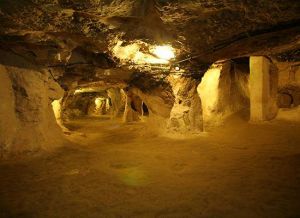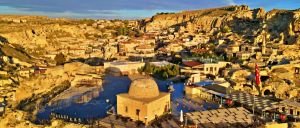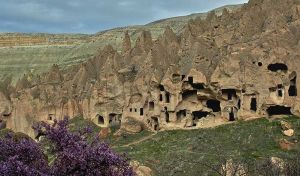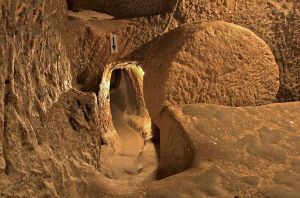The Deep Underground City
The Deep Underground City
Deep: The Rediscovery of an Underground City
Derinkuyu is an underground city in the Cappadocia region of Turkey. It is a historical marvel that fascinates visitors from all over the world. The depth invites us to witness the fears, the excitement, the intelligence, the beliefs, the socialization of the people who lived in this geography thousands of years ago.
What is the depth?
In 1963, when a citizen wanted to renovate the wall of his house, he knocked down the wall with a hammer and found a tunnel in front of him that no one knew about. This tunnel was connected to other tunnels to form an underground city. The name Derinkuyu was given because people supplied drinking water from water wells 60 to 70 meters deep without knowing that there was an underground city here.
The deep, M. Oh, my God. It's a vast underground city dating back to the 8th century, with an elaborate system of tunnels, chambers, and wells that can accommodate up to 1,000 people. It's a vast underground city that stretches back centuries. It is an elaborate system of tunnels, chambers and wells that extends up to 18 floors deep and can accommodate up to 20,000 people. It's an elaborate system of tunnels, chambers and wells that can hold up to 10,000 people. There are living areas, stables, storage rooms and even a church in the city. There are thought to be at least 200 underground cities in the region, Derinkuyu being the largest.
Where's the depth?
Derinkuyu is located in the Cappadocia region of Turkey. This area is famous for its unique landscape, including fairy chimneys and cave dwellings. Derinkuyu is located under the Derinkuyu district of Nevşehir.
Why is it important?
Derinkuyu is an important part of Turkey's cultural heritage. It serves as a reminder of the country's rich history and a testament to the creativity of its people. The construction of the city was a remarkable engineering feat and its purpose was to protect the people from danger, especially from invading armies.
How was it forgotten?
Derinkuyu was abandoned in the 13th century AD. It was abandoned in the century. Although the people who lived in the area didn't use it much, they were aware of the existence of this underground city. In time, however, this information was forgotten. At the beginning of the 20th century, especially the Greeks who lived in the area occasionally used these underground rooms, but with the exchange, this information was completely forgotten, until in 1963 a Nevşehirli entered the home decoration. At the beginning of the 20th century, especially the Greeks who lived in the area used these underground rooms from time to time, but with the exchange, this information was completely forgotten, until in 1963 a Nevşehirli entered the home decoration.
Why did they live underground?
The builders of Derinkuyu lived underground for security reasons. The area was often vulnerable to invasions, and the underground city provided a safe haven for people to retreat to in times of danger. Although it was primarily used to protect against enemy attacks, the seasonally warm air underground from the freezing cold and scorching heat of Nevşehir was a perfect shelter for both people, animals, and crops.
How was it dug?
The pit was dug by hand using only basic tools such as a hammer, chisel, and excavator. The city's builders used the area's soft volcanic rock to create a network of underground tunnels and chambers. They also created ingenious ventilation shafts that allowed air to circulate throughout the city. They did careful engineering to prevent the soft ground from collapsing. In time, everyone dug their own place because the ground was available. And then there were connections between them. There are other underground cities in Cappadocia, but none as sophisticated as Derinkuyu. Deep is an underground city that reaches 20 floors underground, 77 meters deep.
How did people live in the Deep?
Today, Derinkuyu is a tourist attraction and people do not live underground. However, during the period of its use, people lived in the underground city for a long time. The city had living quarters, food storage rooms, and even churches. The main entrances were locked from the inside against dangers with large round pieces of rock. More than 15,000 ventilation channels were opened, each reaching 10 cm wide. More than 3,000 ventilation channels had been opened. It was usually lived on the upper floors because it was airy, and the lower floors were used as storage and dungeons. There are kilometers of underground tunnels connecting the slippery underground city with the Deep. This allowed people to travel to different cities.
What period was it used in?
Although historians disagree, M. Oh, my God. It is thought to have been used since the Hittites in the year 2000. The Greek historian Xenophon M. Oh, my God. In his work Anabasis, written in 400 AD, he talks about how people in Anatolia lived in cities dug underground. During the Christian era, it was often used to protect against Muslim influxes, and during the Mongol invasion, it was similarly used to protect against attacks.
Was it only used in times of danger, or was it always used?
The depth was not always in use, but it was well maintained and ready for use in case of danger. The city was designed to accommodate a large number of people, and supplies were stored in food storage rooms so that the inhabitants could survive for a long time underground. It's hard to live in such an intertwined area underground, but in general, the people who lived in the area were a close-knit community, and disagreements were rare. However, when they appeared, the elders of the community placed them. Usually people live on the ground and use it for special occasions or at night.







Değerlendirmeler